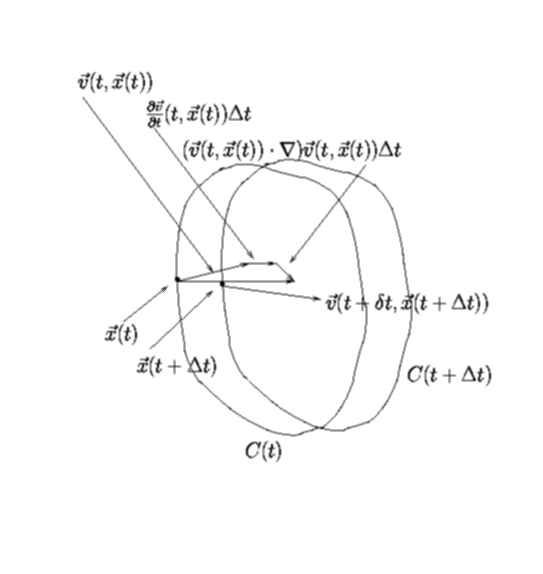To proof Kelvin's theorem, we need to evaluate
![]() ,
and in the proof above the representation of the integral as the limit of a finite sum was used to obtain the expression for
,
and in the proof above the representation of the integral as the limit of a finite sum was used to obtain the expression for
![]() .
Here we discuss how to obtain this expression using the definition of the derivative. We write
.
Here we discuss how to obtain this expression using the definition of the derivative. We write
For a fluid particle at position
![]() (a point over the material contour
(a point over the material contour
![]() ), we can write in the limit
), we can write in the limit
![]() that
that
The speed ![]() of a fluid particle at the position
of a fluid particle at the position ![]() is given by the equation
is given by the equation
This equation is illustrated in the figure below. In the limit
![]() ,
the position
,
the position
![]() (a point of the material contour
(a point of the material contour
![]() )
of a fluid particle at the instant
)
of a fluid particle at the instant
![]() can be approximated by its position
can be approximated by its position
![]() (a point over the material contour C(t)) at instant t, plus what it has traveled during the time
(a point over the material contour C(t)) at instant t, plus what it has traveled during the time ![]() .
The distance traveled is given approximately by the vector
.
The distance traveled is given approximately by the vector
![]() with an error of order
with an error of order
![]() .
.
figure
According to equation (12), we can write
The velocity vector ![]() at the instant
at the instant
![]() can be approximated in the same way as
can be approximated in the same way as
![]() and
and
![]() .
We can write
.
We can write
If we substitute the approximate expression for
![]() ,
given by equation (12), into equation (14), we obtain
,
given by equation (12), into equation (14), we obtain
Now we expand ![]() in taylor series with respect to the second variable to obtain
in taylor series with respect to the second variable to obtain
The expanssion above is illustrated in the figure below

According to equations (13) and (16), the integrand of the first integral in the right hand side of equation (9) can be approximated by the equation
Notice that the approximated form of the integrand of the first integral in the right hand side of equation (9), given above by equation (17), is now being evaluated over the contour C(t) instead of the contour
![]() .
Therefore, we can write
.
Therefore, we can write
Now we can replace the first integral in the right hand side of equation (9) by the expression given in the equation (18). Therefore, the time derivative of the circulation is
 |
(19) |
and after the limit process is taking into account, we obtain
 |
(20) |
which is exactly the equation (7) we obtained using the previous approach.